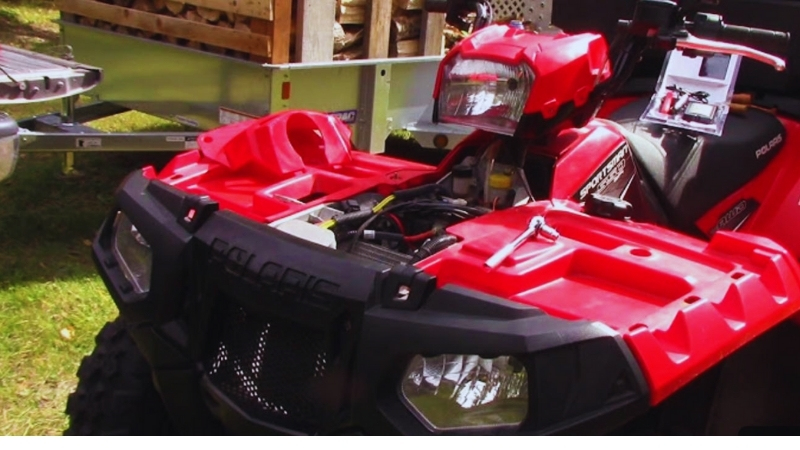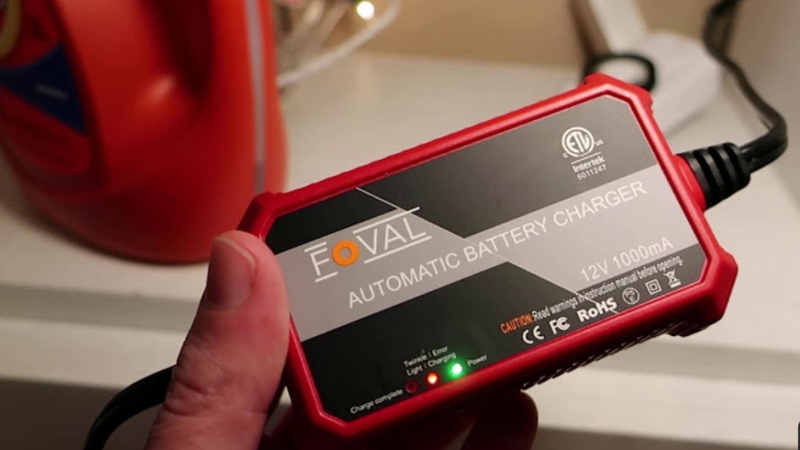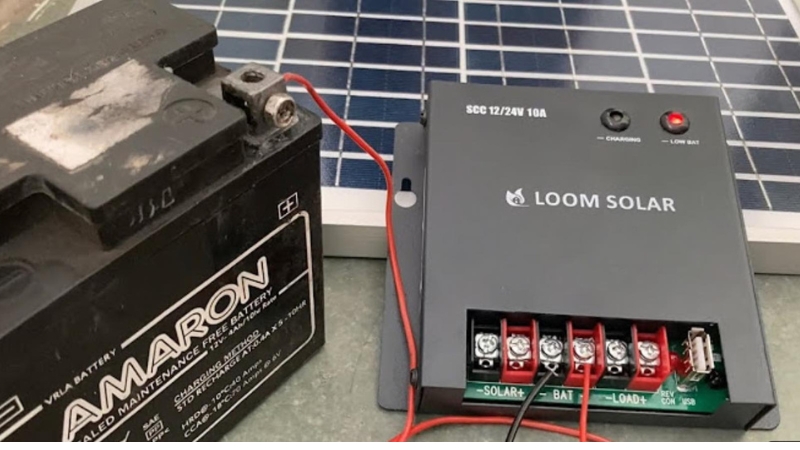ATV batteries are essential components of any off-road adventure. If you’re an avid outdoor enthusiast, you’ve had to deal with a dead battery. But what if you don’t have access to a charger? Can your ATV battery be topped up without one? The answer is yes.
You can use a car battery, a solar panel, a generator, a UPS inverter, a battery isolator, a jump starter, and more to charge an ATV battery. Whatever method you use, you must check the compatibility of the charging source and your ATV battery on top of their voltage rating.
Because the lower voltage rating of the source will undercharge while the higher voltage will not only overcharge but may cause significant damage.
This blog post will discuss how to charge an ATV battery without a charger covering the complementary factors.

Jump To Contents
What You Will Need
Assuming that you have a 12-volt ATV battery, you will need the following items:
- A voltmeter or multimeter
- Clean and dry cloth
- A set of jumper cables
- Another vehicle with a working battery
Ways to Charge an ATV Battery Without a Charger
While we always recommend using a charger to charge an ATV battery (preferably one made specifically for your battery), we understand that sometimes you don’t have one handy. So, we’ll show the smart ways of charging an Atv battery without a charge.
Using Car Battery
First, if you don’t have a charger, you will need another power source to charge your battery. The most common power source people use is a car or truck battery. Just be sure your car or truck battery has enough juice to charge your ATV battery. If not, you could end up damaging both batteries.
Once you have your power source, you’ll need some jumper cables. Connect the positive (red) terminal of the power source battery to the positive terminal of your ATV battery. Then connect the negative (black) terminals of both batteries.

Finally, turn on the power source and let it run for a while (we recommend at least an hour). Once it’s done charging, disconnect everything in the reverse order, and you should be good to go.
Just remember, while this method will work in a pinch, it’s not ideal and can be dangerous if done improperly. We always recommend using a compatible charger if you want to enjoy the full battery life.
Using Portable Jump Starter
Jump-starting using leads means bringing your dead ATV battery back to life quickly and efficiently. But did you know that you can also use a jump starter to charge it? Most modern jump starters have a USB port to charge devices like smartphones and tablets. This same port can be used for charging your ATV battery as well.

Make sure you choose one with enough power output and capacity for your specific model of ATV. And that is when you should always read the instructions carefully because you cannot take a chance attempting any maintenance or repair work on your vehicle’s electrical system.
You must turn off all other electronics and systems to minimize the drain on the battery and allow as much power as possible to go toward charging your battery. If you leave headlights, air conditioning, or other accessories on, they will consume some of the energy from your jump starter and make it less effective at starting your car.
With A UPS Inverter
If you don’t have access to a regular outlet or charging station, one option is to use a UPS (Uninterruptible Power Supply) inverter to charge your battery.
First, make sure your ATV battery is compatible with the voltage output of your UPS inverter. Most ATV batteries require 12 volts, so ensure your inverter can provide this power.
Next, connect the positive and negative terminals of the inverter to the corresponding terminals on the battery. Once connected, turn on the inverter and let it run until the battery is fully charged.

It’s important to note that using a UPS inverter may take longer than traditional charging methods and may be less efficient. However, it can be a useful option when other charging methods are not available or feasible.
Jump Starting with Jump Leads
Jump-starting an ATV using jumper cables can be a quick solution when needed. For that, you need a car with a running engine.
Ensure that the ATV battery is dead before attempting to jump-start. Once confirmed, locate the battery terminals and identify the positive (red) and negative (black) terminals.
Then, connect the positive lead of the jumper cable to the dead battery’s positive terminal, then connect the other end of the cable to a live battery’s positive terminal.
Next, connect the negative lead of the jumper cable to a live battery’s negative terminal, followed by connecting its other end to an unpainted metal surface on your ATV away from fuel lines or moving parts. Ensure that all connections are secure before starting up both vehicles.
Finally, start up the live vehicle and let it run for several minutes while keeping your ATV off. Afterward, attempt starting up your ATV.
If successful, disconnect cables in reverse order, ensuring they do not touch each other or any metal surfaces until fully disconnected. Safety should always come first, as mishandling these cables can cause damage and injury.
Using a Battery Isolator
A battery isolator is an electrical device that connects multiple batteries to a single power source. It ensures that each battery remains isolated, preventing any particular battery’s inefficient discharge or overcharge.

You can charge your ATV battery using a battery isolator.
First, connect your main charging source alternator to the input of the isolator using wires. Then, attach the output wires from your ATV’s starter battery and other auxiliary batteries to their respective terminals on the isolator.
Finally, please turn on your charging source and let it do its work.
Charging your ATV’s batteries with an isolator ensures the batteries are charged optimally without risking overcharging or undercharging.
Using Solar Panel
If you have a solar panel, you can use it to charge your ATV battery by connecting the positive and negative terminals of the panel to the corresponding terminals on the battery. Most solar panels come with instructions on how to do this. Once the connection is made, the sun will do the work of charging your battery.

Depending on how strong the sun is and how big your solar panel is, it could take anywhere from a few hours to a full day to charge your battery. Creating your own homemade solar panel is another great choice for those who are mechanically inclined and looking for an even cheaper option than a commercial solar panel.
Using Generator
If you have a generator, you can use it to charge your ATV battery by connecting the positive and negative terminals of the generator to the corresponding terminals on the battery. Again, most generators come with instructions on how to do this. Once the connection is made, turn on your generator and charge the battery.
Using USB port
Another convenient way to charge your ATV battery is using a USB port. Many ATVs come with USB ports that allow you to connect your phone or other devices while on the go. You can also use these ports to charge your ATV battery by connecting a USB charger and cable.
It’s important to note that charging your ATV battery via USB will take longer than using a traditional charger. The charging time will depend on various factors, such as the size and capacity of your battery and the charge level. However, if you’re in a pinch and need extra juice for your ride, a USB port can be a handy solution.
Factors to Consider while Charging a Battery without a Charger
Charging a battery without a charger may seem easy, but it is crucial to exercise caution since it could pose serious risks. By observing these simple precautions, you can safely charge your batteries without damaging them or causing injury.
Types of Battery: The first factor to consider is the type of battery your ATV uses. Different batteries require different methods. Especially lithium-ion batteries are different in every aspect. So, to avoid any untoward situation; it is crucial to know what battery type you have and follow the manufacturer’s recommendations for charging.
Voltage and Amperage: Ensure you use the correct voltage and amperage when charging the battery. Using too high a voltage or amperage can cause an explosion or fire.
Track Charging Progress: Make sure that the battery is not overcharged, as this may lead to permanent damage to the cells of the storm. You can check for signs such as bulging the battery casing or excessive heat during charging. The multimeter will help you to keep track of the charging progress.
Well-ventilated Set up: Always charge batteries in a well-ventilated area and away from flammable materials. Also, never leave batteries unattended while charging, as this may cause a fire hazard due to overheating.
How often should you charge your ATV battery?
Assuming you are talking about a lead acid battery, it must be charged when low. You can tell when it is low because it will be hard to start the engine or there will be a drop in power while driving. People often charge their batteries every time they use their ATV, but this isn’t necessary.
If you regularly ride your ATV and it always starts and has plenty of power, you don’t need to charge it after every ride. Just keep an eye on it and fully charge it when necessary.
For Lithium-Ion batteries, you should charge them as soon as you notice they are running low. Keeping them between 20-80% charged is best because this will extend the battery’s life.
Charge Your ATV Battery Safely and Accurately
Charging an ATV battery with a charger is easier than it may seem and can be done with suitable materials. Following the ways, precautions, and suggestions above, you can quickly charge your ATV battery and return to the trail. These methods require some knowledge and experience to charge a battery safely and accurately properly.
So, it is essential to thoroughly research the best option for your specific needs before attempting any of these methods. Not to ignore, protective gear should be worn at all times, and proper safety precautions should be taken when dealing with electricity and batteries.